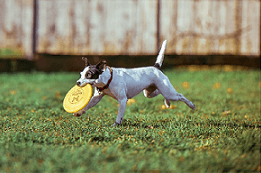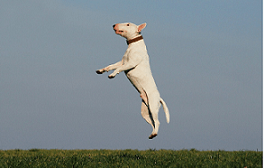Do all dogs need the same amount of exercise?
All dogs need exercise, but knowing how much exercise is enough will depend on various factors including your dog’s breed, age and health. Even within breeds and age groups there will be variations as no two dogs are the same.
Sporting and herding breeds, for example, will need more exercise than traditional guarding breeds, just as younger dogs will be more active and demanding of exercise than geriatric animals.
Generally speaking, puppies need slightly less exercise as their bones are still developing and too much vigorous activity in puppyhood can be harmful to the joints, potentially leading to arthritis and hip dysplasia in later life. In larger breeds and those more prone to joint problems and obesity, it is worth starting them on a joint supplement such as Joint Force or Yumove at an early age, to help support and maintain healthy joints throughout their life.
 Health vs Behaviour
Health vs Behaviour
We tend to think of exercise purely as a health issue, but actually it has a huge effect on a dog’s behaviour too. Dogs that aren’t physically stimulated will have pent-up energy and frustration, meaning they will be more likely to develop disobedient and destructive habits. If you want a dog that is calm, mannered and well socialised, regular exercise is fundamental.
The problem of obesity
Dogs that are bored and seldom exercised are also more likely to be obese, which has major health implications now and in the future. Not only does obesity contribute to a dog’s diabetes risk, it also jeopardises respiratory and heart health, exacerbates orthopaedic problems like arthritis and hip dysplasia, and puts pressure on all the vital organs and structures in the body.
It is commonly thought that smaller dogs require less exercise than bigger dogs, but often they get far, far less than they really need. Smaller dogs like pugs and bulldogs are more prone to obesity and ideally need to get out for a run around every day; it is not enough to simply let them play indoors.
Is there a guideline I can follow?
The Kennel Club suggests a suitable ratio of five minutes’ exercise for every month of age (up to twice a day) in puppyhood. A puppy aged two months old would therefore only require ten minutes of exercise every day. Of course, don’t panic if you think your dog has exercised more than this; puppies are naturally boisterous and there's no need to curb their playfulness. (Bear in mind that dedicated exercise is in addition to a dog’s normal daily activities.) There will also be other factors that affect this general rule, so only use it as a rough guide.
 Ideally you should try to avoid high-impact activities that put pressure on your puppy’s developing joints, such as frisbee, jumping, and excessive running. Be mindful of how you exercise breeds like corgis and dachshunds that are more prone to spinal injuries due to their elongated backs. If your dog is dysplastic-prone for any reason, avoid these high-impact activities altogether.
Ideally you should try to avoid high-impact activities that put pressure on your puppy’s developing joints, such as frisbee, jumping, and excessive running. Be mindful of how you exercise breeds like corgis and dachshunds that are more prone to spinal injuries due to their elongated backs. If your dog is dysplastic-prone for any reason, avoid these high-impact activities altogether.
For active, adult breeds, 30-60 minutes of exercise a day is needed to stay fit and healthy. In fact, the best gauge is to keep going until your dog tires – if, after 60 minutes, your dog is still raring to go, stay outside a bit longer. Busy lifestyles don’t always make this possible, so if it suits you better to split the exercise into two sessions i.e. morning and night, this is also fine.
If the weather isn’t great, consider ways you can exercise your dog indoors. Hide treats around the house which require your dog to look for them, play fetch along the carpet, run up and down the stairs (not recommended if your dog has short legs and a long back e.g. corgis, dachshunds and basset hounds).
We'd love to hear from you about the amount of exercise your dog gets and the activities you most enjoy doing, so please comment below and let us know!
Written by: Hannah

